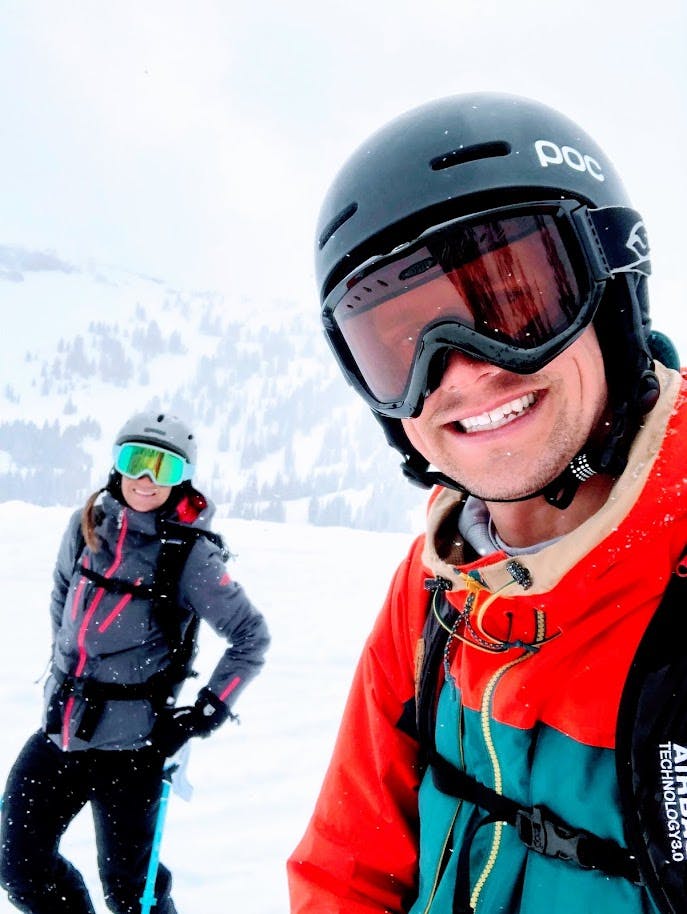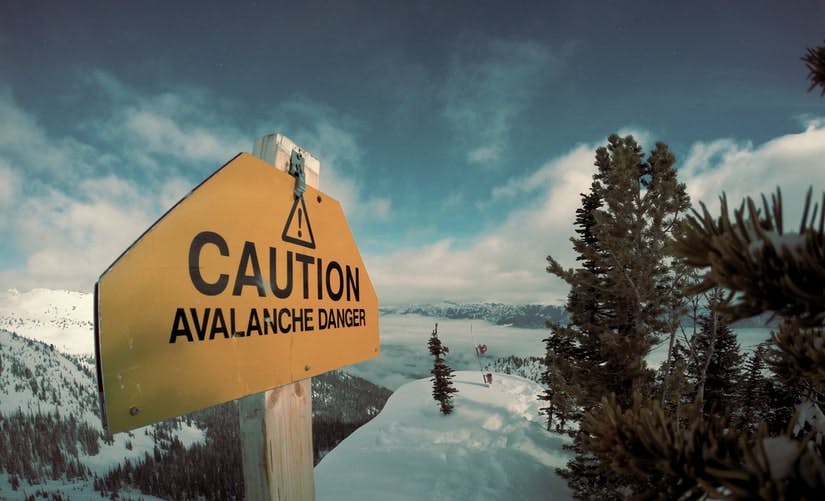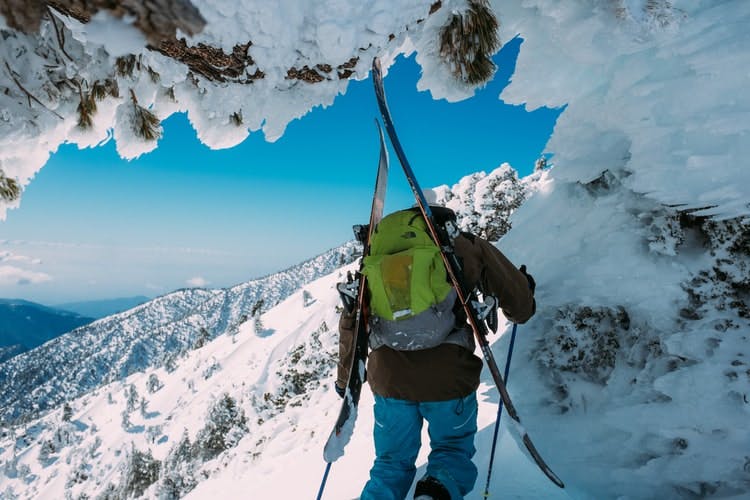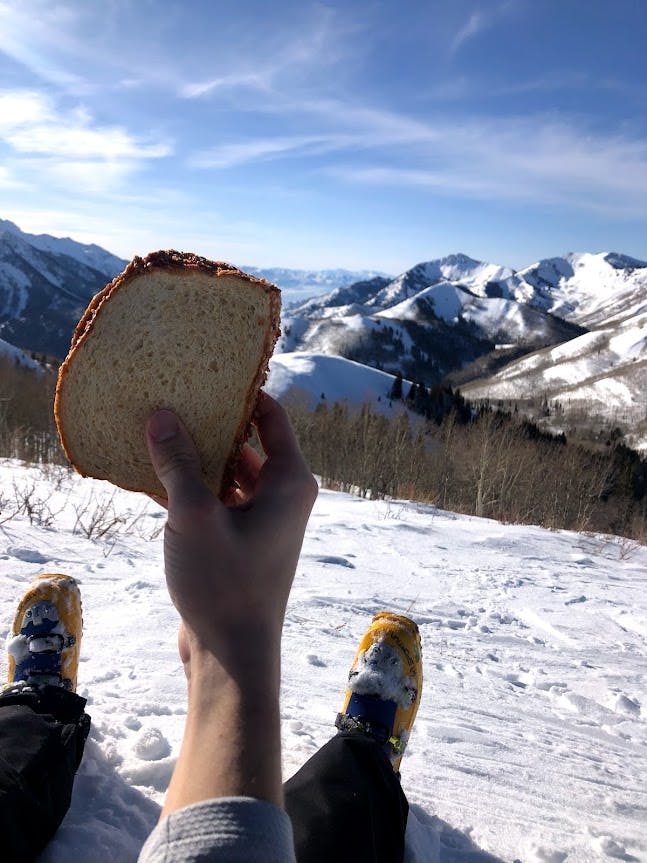Skiing out of bounds, or off-piste, has become increasingly popular. While some skiers access the backcountry and sidecountry through gates from ski resorts, others opt to start in the parking lot or on the side of the road and skin or bootpack their way to the promise of untracked snow. Regardless of how you get there, there is no better reward for your efforts than an untouched powder field—a blank slate just waiting for you to claim your face shots! But the backcountry is a dangerous place, claiming the lives of unprepared skiers every year. Being prepared with not only the right gear, but the education and knowledge of how to use it is key. Below are eleven things you need before skiing out of bounds to ensure that you have a safe and epic day!
The Absolute Essentials
There are two things that you should absolutely not go into the backcountry without: a plan and a partner. While these two things are not “gear,” they are imperative to a backcountry skier's safety and survival.
1. A Plan
Before exiting the resort and beginning your out of bounds ski adventure, you must always, always, always have a plan.
Begin by asking yourself: what is the current weather? What is the forecasted weather? What is the avalanche danger for the day? Do you have a route chosen? Do you have a back-up route chosen? Do you know who to contact in an emergency situation? Do you know how to contact them? What if you don’t have service? What if you get lost? What if you get hurt?
These are all questions that you need to know the answer to before heading out of bounds. A lot can go wrong once you leave the resort and are in unpatrolled, unmarked territory, and the mountains are unforgiving. An unexpected storm can roll in, dropping the temperature, decreasing visibility, and creating dangerous conditions. On the other hand, the sun may come out on an overcast day, warming the snow and creating high avalanche danger. Without marked trails, it’s easy to get turned around, and it may take hours or even days to recover from getting lost. Having the gear and the tools listed below and a plan for how and when to use them may be the difference between a great day and a terrible one.
2. A Partner

Photo courtesy of Kat Smith
One of the most important rules of off-piste skiing is never doing it alone. Skiing is inherently dangerous, even if you are in-bounds at a resort. That danger increases ten-fold when you are outside of the resort and ski patrol isn’t flagging hazards and performing avalanche mitigation. It’s great if you are educated on avalanche safety and wilderness rescue, but if you don’t have a partner, who is saving you if you are the one who gets buried or hurt? Who is going for help if you are injured, unable to ski out, and you don’t have cell phone service? Plus, not only can your backcountry partner save your life, but skiing with a buddy is way more fun!
Avalanche Safety and Rescue Gear
If you are skiing in avalanche terrain, which includes the out-of-bounds territory off of nearly every resort in the Mountain and Western U.S. and Canadian time zones, you must be prepared with avalanche safety and rescue gear, and more importantly, the knowledge and skills to use it correctly and efficiently. An avalanche victim has approximately twelve minutes before asphyxiation takes their life, so during a rescue, every second counts. The three tools necessary for the most efficient recovery are an avalanche transceiver, an avalanche probe, and an avalanche shovel. Having only two of these items but missing the third significantly decreases a buried victim’s chance of survival, so be prepared with all of the gear and the knowledge.

Photo by Nicolas Cool
3. Avalanche Transceiver
If you are a frequent out-of-bounds skier, you have likely seen those large, yellow and red signs posted at backcountry access gates and trailheads that ask “Are You Beeping?” In other words: do you have an avalanche transceiver on you?
An avalanche transceiver or avalanche beacon is a device that is used to locate buried avalanche victims by sending and receiving signals to and from other nearby transceivers. You and your partner or group should never leave the safety of the patrolled, mitigated, in-bounds terrain without one. An avalanche can carry a victim for hundreds of yards before it stops and settles, so using guesswork to find your buried friend will not work. If all members of your group are equipped with a transceiver (and they all know how to use it!), you are giving yourself and your partner(s) the best chance possible for survival if an avalanche is triggered.
4. Avalanche Probe
A probe is a collapsible metal rod at least two meters in length that is used to pinpoint a victim’s exact location after the transceiver has determined their approximate location. A person can be buried meters beneath the snow, so the longer the probe, the better. If you skip this step, you may waste valuable time and energy digging into the hard, settled snow just one foot too far to the right of your friend.
5. Avalanche Shovel
As soon as you strike the victim with your probe, start digging! Many avalanche shovels are collapsible so that they fit in your pack, so practicing even the small details of putting your gear together can save precious seconds. After an avalanche, the snow settles and packs down, and digging through it can feel like you are trying to move concrete. Do not rely on your hands or your ski in place of a shovel! Having a metal shovel, knowing the most efficient digging technique, and practicing it yearly can make this process as fast as possible.
There is no point in having an avalanche transceiver, probe, and shovel if you don’t know how to use them! Get educated through your area’s avalanche center, such as the Utah Avalanche Center (UAC) or the Colorado Avalanche Information Center (CAIC). Practicing using the equipment at Beacon Parks, which are set up at resorts across the country will keep your skills sharp. An avalanche rescue is a stressful and chaotic environment, especially when the victim is a loved one! If you are prepared with the appropriate equipment and education, you can save lives.
Emergency and Survival Gear
Any time you venture into the backcountry or sidecountry, you should have a backpack that is stocked with emergency and survival gear, whether you are leaving from a resort gate or from the trailhead. These items are necessary for your survival if things go awry and should always be readily accessible.
6. A Backpack

Photo by Robson Hatsukami Morgan
First thing’s first, get yourself a backpack. How else will you carry your emergency and survival gear?! Outdoor gear brands such as Osprey and Patagonia make skiing-specific packs, equipped with compartments for avalanche safety gear, accessory loops for multiple carry options for your skis, and stash pockets for your helmet and goggles. Your backpack should be properly fitted, large enough to hold all your essential gear, and organized so you can easily access it.
7. First Aid Kit
You may not be carrying life-saving first aid supplies, but having items such as wound care, blister care, and muscle pain relief can certainly save your day! A hot spot at the beginning of the skin track can quickly become a blister by the time you’re only a quarter of the way to the summit. Skiing back to the parking lot with a sprained knee may be more tolerable, and even made possible, if you have an ace wrap to provide support after a misstep or a caught edge. Having antibacterial ointment and a bandage to clean up a cut from hitting a low-hanging tree branch may save you from ending the day early. Keep the adventure going! Be prepared for the little things.
8. Navigation Tools
As mentioned above, it’s easy to get lost when there are no trail markings. And when there’s a fresh blanket of snow covering the previously well-formed boot pack or skin track, it’s even harder to find your way. Avoid asking yourself, “Have we passed this tree before?” and be prepared with a navigation tool and a map of the area. A basic compass such as the Silva Starter 1 2 3 Compass is all you need to find your way, but some people prefer an electronic GPS navigation system, equipped with the ability to load maps and routes, send texts and emails in out-of-service areas, and an SOS function, such as the Garmin inReach Mini GPS.
9. Extra Layers
Weather changes quickly in the mountains—a beautiful, sunny day can turn into a full-on blizzard, a calm, peaceful morning can turn into a cold and windy afternoon, and once the sun sets behind the mountain tops, the temperature drops quickly. Once you’ve left the ski resort and are on your own (with your partner, of course) in the backcountry or sidecountry, it can take hours to get back to the safety of a lodge or your car. Be prepared for weather changes and for the day to take longer than you’ve planned by having an extra layer (or a few!) stashed in your pack.
I always pack my Patagonia Nano Puff Jacket. It packs up small and light but has great insulation to retain my body heat and keep me warm. A beanie such as The North Face Salty Bae Beanie and a dry pair of gloves are also great layers to have for added warmth and to prevent frostbite on those at-risk areas such as the tips of your ears and your fingers. Many people will pack an emergency blanket, such as the MPI Emergency Blanket, which can help prevent hypothermia if you find yourself in a situation where you are spending the night or long hours in the backcountry waiting for rescue.
10. Water and Snacks

Photo by Jos Smith
You should always carry a full water bottle and snacks any time you are leaving the ski resort and going into the backcountry or sidecountry. Dehydration is commonly thought of as a condition that we are only at-risk for in hot weather, but that couldn’t be further from the truth! When you are working hard skinning, boot packing, transitioning your ski setup, and then downhill skiing, dehydration is a very real concern! And as mentioned above, plan for changing conditions and the unexpected. Always pack a full water bottle, and monitor your thirst. Many people will also pack a water purification method such as Potable Aqua Water Purification Tablets. These are lightweight, take up nearly no space in your pack, and give you the option to safely drink from a running stream if you find yourself in an emergency situation.
You ate a huge breakfast and your out-of-bounds plan is to only do one lap of a pretty short run that you’ve done a hundred times before and will only take a couple of hours. So why take up space and add weight to your pack with snacks? As mentioned above, while it is so important to have a plan, a large part of the plan is planning for the plan to fail! That’s where snacks come in. There are many reasons why a planned morning in the backcountry can become an entire day, and having snacks will stave off your hunger, keep you thinking clearly, and keep you fueled for physical exertion. Not only is it important to have snacks in case the worst should happen, but skiing is hard! Don’t underestimate your calorie exertion! Some of my go-to backcountry skiing snacks include a PB&J sandwich, granola bars, trail mix, and apple slices.
11. Cell phone
Your cell phone may be your lifeline. Having the ability to call Search and Rescue or refer to a live map may get you out of a tough situation. But don’t rely solely on your cell phone! Many backcountry ski zones have unreliable service. Have a backup plan and a method for how to call for help. As mentioned above, an electronic GPS navigation system with an SOS function is a great, reliable alternative.
In addition to the items listed above, many experienced backcountry skiers would never dream of heading off-piste without a headlamp and extra batteries, an emergency shelter, a lighter or fire starter, a multi-tool, and ski straps or gear repair equipment.
Next time you are skiing and pass by that backcountry exit gate and are tempted to take a few laps out of bounds in the fresh pow, take a beat and ask yourself: “Am I equipped with a plan, a partner, avalanche safety and rescue gear, and emergency and survival gear?” If the answer is no, then stay in bounds! A few face shots are not worth your life, and the exit gate will still be there tomorrow. Make a plan, find a buddy, and get the gear! If you have any questions or want to gear safely geared up for your next backcountry adventure, reach out to a Ski Expert here on Curated.





Comments